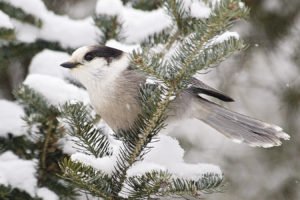It was an announcement in mid-November that many Canadians didn’t see coming. That’s when the Royal Canadian Geographical Society (RCGS), publisher of Canadian Geographic magazine, at their AGM in Ottawa set the media abuzz with their official recommendation that the grey jay be Canada’s national bird as part of the celebrations for the country’s 150th year of existence this year. RCGS had selected the grey jay—more commonly known as the whisky jack and before 1957, as the Canada jay—after an online popular vote by Canadians, a lively public debate and consultations with experts.
But at first, the decision didn’t sit well with some Canadians.
For starters, the grey jay had placed third in the popular vote, behind the common loon and snowy owl. After almost 50,000 votes were cast, the top five birds out of the 450 species found in Canada were the common loon (13,995), snowy owl (8,948), gray jay (7,918), Canada goose (3,616), and the black-capped chickadee (3,324). So, how did a third-place choice come to be top bird?
According to RCGS, it was the result of a three-phase process. In January 2015, Canadians were asked to vote for a “bird species that could represent this nation of forest, prairie grassland, Arctic and sub-Arctic, maritime and wetland, agricultural and urban areas and many other habitats.” When voting closed on August 31, 2016, Canada’s top five favourite birds had been decided by popular vote. That kicked in phase 2; in September 2016 the RCGS convened a panel of experts that debated which of the five birds they believed “most worthy of the honour” and they chose the gray jay.
“You’ve got a bird that’s intelligent, friendly and hardy—and that to me epitomizes Canadians,” said David Bird, emeritus professor of ornithology, McGill University.
Adding to the controversy was that RCGS used the American spelling of ‘gray’ in the announcement instead of the Canadian spelling ‘grey.’ That however quickly died down, as most Canadian media used grey jay or its common moniker whisky jack.

Actually, neither name is official. The bird was first named in 1766 by Sweden’s Carolus Linnaeus (who developed the biological classification) with its Latin scientific name Perisoreus canadensis, which translated into English is Canada jay, the name used in English for the next 191 years. That changed in 1957 when the American Ornithologists’ Union renamed it ‘gray jay’ (American spelling) in its Check List of Northern American Birds. But since its official scientific name didn’t change, the argument is made therefore that the only official English name is Canada jay.
Most Canadians best know the bird by its moniker whisky jack, which comes from the Anglicization of the Cree-Ojibway name wisikejack, meaning “mischievous prankster.”
Some Canadians (mainly urban dwellers) said they’d never seen or heard about the bird, asking “The grey what?” and there was a Twitter storm of comments about why the common loon—already the provincial bird of Ontario and state bird of Minnesota—didn’t get top spot. And some thought the search for Canada’s national bird was just a publicity stunt for the magazine.
Regardless of the controversies, Canadians have enthusiastically now embraced the idea of the whisky jack becoming Canada’s national bird. And here’s some reasons why the experts chose the third-place grey jay/whisky jack as the top bird.
The grey jay is found year-round in every Canadian province and territory and except for certain parts of the U.S., does not exist anywhere else, nor has any geographical entity claimed it as an official bird. She is prominent in First Nations folklore; lives in the boreal forest; doesn’t migrate; and, is so cold-hardy, she has even been observed incubating eggs in temperatures as cold as -30C. About the size of a blue jay, she is a member of the corvid family (crows, ravens, magpies and jays) and considered an intelligent bird with a brain-to-body ratio similar to that of dolphins and chimpanzees. Extremely friendly, many of us in the Northern Wilds can tell stories about enticing the whisky jack with some food to land on our shoulder or hand.
“So we’ve got ‘smart,’ ‘hardy,’ ‘friendly’ and ‘loyal.’ What greater way to describe the typical Canadian, eh?” wrote Bird in the Ottawa Citizen article “Not so loony: why the grey jay soared to victory as Canada’s would-be national bird” (Nov. 26, 2016).
Canada, which came into existence in 1867, has big plans for its 150th anniversary this year, and there’s lobbying going on for the Canadian federal government to officially designate the ‘grey jay’ as its National Bird during its celebratory year.
By Elle Andra-Warner

